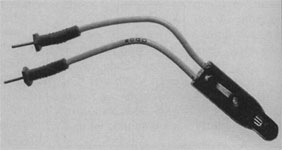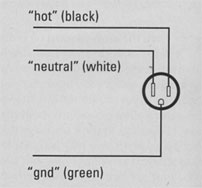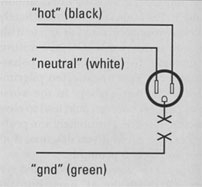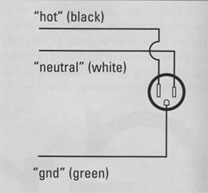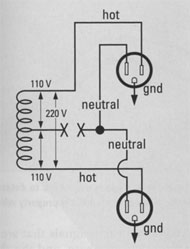| On Solid Ground, part 1 (continued) |
|
|
Be aware that the third prong isn't necessarily connected to anything (see Fig. 2). Don't make foolish assumptions; test the circuit. If you find a problem, call the electrician; it's cheaper than a fire or a hospital bill. If you only have 2-conductor outlets, you can use a neon circuit-tester (also available from Radio Shack and most other electronics stores; see Fig. 3) to test the ground. Put one end of the circuit tester on the metal screw that secures the cover plate of the outlet, making sure there is no paint on the screw head. (Paint is an insulator.) Put the other in the socket itself (in the small slot of a polarized plug). If the tester glows, you have a good ground.
FIG. 3: Neon circuit testers use a neon bulb to determine whether an outlet or piece of equipment is properly wired. If you don't have a good ground-don't be surprised if the screw isn't grounded at all-you can solve the problem by connecting the outlet casing to a copper-not plastic-water pipe using a heavy-gauge wire (12 AWG or bigger). However, this might not be possible, as many buildings now use plastic water pipes, which are not conductors. In this case, have a qualified electrician create a true earth ground by driving a copper rod into the ground (preferably moist, salty earth, as salt water is a superior conductor) and connecting it to the outlet casings in the house. |
|
WARNING It is most important to keep in mind that when it comes to AC wiring, government and insurance underwriters' electrical codes take precedence over anything suggested here. These rules and regulations, which vary in different regions, are designed for safety, and safety always comes first. If you are unsure of what you're doing, call a professional electrician. |
|
In some studios, the ground of the circuit powering the equipment is isolated from the rest of the building's circuits. As a result, all the outlets on the studio circuit are grounded separately from all other circuits in the house. This is accomplished by disconnecting the ground for the studio circuit from the grounding strip in the breaker box and wiring a separate, true earth ground. The electrician must install special colored outlets to accommodate this type of circuit. Each special outlet is connected to the separate ground by an additional wire in the wall conduits. |
|
Power To The People By Steve Oppenheimer Regardless of where your local electric company gets its juice, the AC power reaches your house by way of two 117-volt hot wires (at a frequency of 60 Hz, +/-001%), each carrying a signal that is 180 degrees out of phase with the other. In reality, the AC signal fluctuates above and below 117 volts, depending on the demand for electricity on your local network at any point during the day. You also have a neutral wire and a ground wire. The neutral wire is grounded to earth at the local utility pole's step-down transformer. At the service point where the power line enters the house, the neutral wire is grounded again. The ground wire is a conductor brought in from the service point to provide a safety ground for the chassis of anything plugged into the outlet. It normally is connected to the building's cold-water system, assuming you have copper water pipes and not plastic. If the entire house has plastic pipes, a six-foot copper rod may be driven into the ground to create a true earth ground. The ground wire normally is at the same potential as the neutral, but not always. There is sometimes a current in the neutral wire, which is why it should never be connected to the ground wire. All the wires meet in a metal box with fuses or circuit breakers. From this box, the power is divided into two main strips, or legs, which run down the left and right side of the box. Each leg consists of one 117 VAC hot line that shares a common neutral wire. Each of these legs is then divided into 15-, 20-, or 25-amp circuits that run to different parts of the house. At the bottom of the breaker box, you usually find a strip that connects all the grounds from the different circuits to the main ground wire. For heavy-duty appliances such as an electric stove, both hot legs are used to create a 240-volt line. In industrial areas, several different three-phase wiring schemes are |
commonly used, including both 240-volt and 480-volt systems. Some systems also provide 208 VAC and 277 VAC legs for motors and fluorescent lights. If you plan on hooking into these systems, you should have a qualified electrician do it for you. Most modern electrical boxes have circuit breakers rather than fuses. The circuit breakers are designed to protect the electrical system from overloads. If the current drawn from a circuit exceeds the maximum value of the breaker, the breaker trips and shuts down the power to that circuit. This safety feature prevents the circuit from overheating and causing damage to equipment, or even starting a fire. In a properly wired, polarized 2-prong outlet, the left (long) prong is neutral, the right is hot, and the mounting screw is ground. In a 3-prong outlet, the third (cylindrical) prong is ground. The wiring in buildings varies depending on local building codes, but most conform to a more or less universal color code for the different wires. Normally, white is used for the neutral, ground is green, and hot is anything but white or green, with black being the most widely used color. If you recognize this scheme as being similar to unbalanced audio connections, go to the head of the class. In both cases, a hot signal in one conductor is accompanied by a neutral signal in the other conductor. In balanced connections, two hot signals that are 180 degrees out of phase with each other are carried in two conductors while the neutral signal is carried in a third conductor. This eliminates any noise induced by external electromagnetic radiation from devices such as electric guitars, which appears in all conductors at the same phase. In England, the AC power system is balanced, which is why British studios are generally more hum-free than their American counterparts. Unfortunately, American electrical codes do not provide for balanced AC power lines. |
return to top |
|
